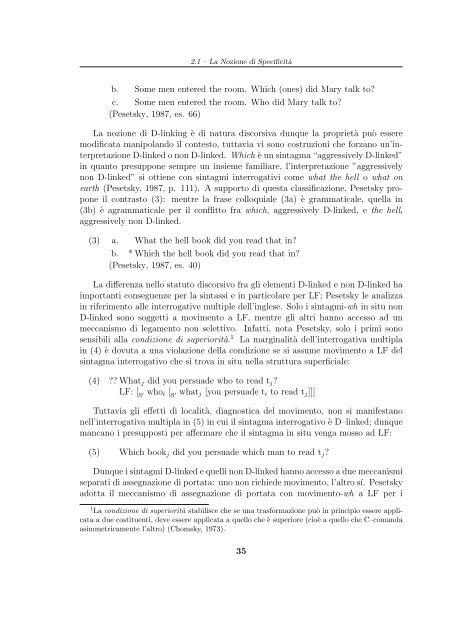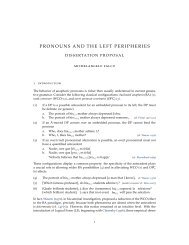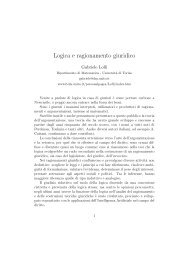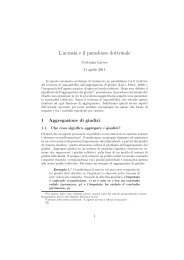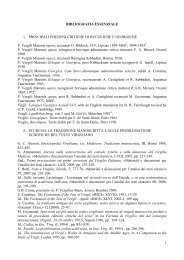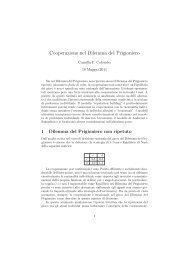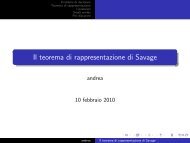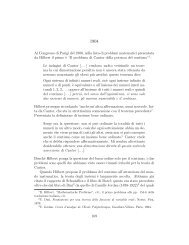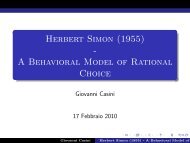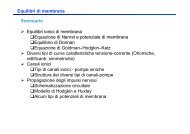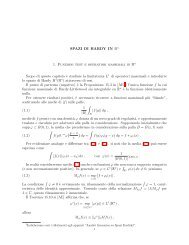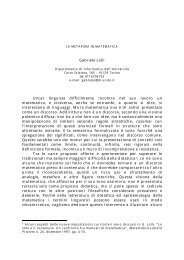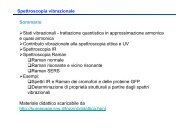Scavalcamento Debole e Catene in Forma Logica - Pagine ...
Scavalcamento Debole e Catene in Forma Logica - Pagine ...
Scavalcamento Debole e Catene in Forma Logica - Pagine ...
Create successful ePaper yourself
Turn your PDF publications into a flip-book with our unique Google optimized e-Paper software.
2.1 – La Nozione di Specificità<br />
b. Some men entered the room. Which (ones) did Mary talk to?<br />
c. Some men entered the room. Who did Mary talk to?<br />
(Pesetsky, 1987, es. 66)<br />
La nozione di D-l<strong>in</strong>k<strong>in</strong>g è di natura discorsiva dunque la proprietà può essere<br />
modificata manipolando il contesto, tuttavia vi sono costruzioni che forzano un’<strong>in</strong>terpretazione<br />
D-l<strong>in</strong>ked o non D-l<strong>in</strong>ked. Which è un s<strong>in</strong>tagma “aggressively D-l<strong>in</strong>ked”<br />
<strong>in</strong> quanto presuppone sempre un <strong>in</strong>sieme familiare, l’<strong>in</strong>terpretazione ”aggressively<br />
non D-l<strong>in</strong>ked” si ottiene con s<strong>in</strong>tagmi <strong>in</strong>terrogativi come what the hell o what on<br />
earth (Pesetsky, 1987, p. 111). A supporto di questa classificazione, Pesetsky propone<br />
il contrasto (3): mentre la frase colloquiale (3a) è grammaticale, quella <strong>in</strong><br />
(3b) è agrammaticale per il conflitto fra which, aggressively D-l<strong>in</strong>ked, e the hell,<br />
aggressively non D-l<strong>in</strong>ked.<br />
(3) a. What the hell book did you read that <strong>in</strong>?<br />
b. * Which the hell book did you read that <strong>in</strong>?<br />
(Pesetsky, 1987, es. 40)<br />
La differenza nello statuto discorsivo fra gli elementi D-l<strong>in</strong>ked e non D-l<strong>in</strong>ked ha<br />
importanti conseguenze per la s<strong>in</strong>tassi e <strong>in</strong> particolare per LF; Pesetsky le analizza<br />
<strong>in</strong> riferimento alle <strong>in</strong>terrogative multiple dell’<strong>in</strong>glese. Solo i s<strong>in</strong>tagmi-wh <strong>in</strong> situ non<br />
D-l<strong>in</strong>ked sono soggetti a movimento a LF, mentre gli altri hanno accesso ad un<br />
meccanismo di legamento non selettivo. Infatti, nota Pesetsky, solo i primi sono<br />
sensibili alla condizione di superiorità. 1 La marg<strong>in</strong>alità dell’<strong>in</strong>terrogativa multipla<br />
<strong>in</strong> (4) è dovuta a una violazione della condizione se si assume movimento a LF del<br />
s<strong>in</strong>tagma <strong>in</strong>terrogativo che si trova <strong>in</strong> situ nella struttura superficiale:<br />
(4) ?? Whatj did you persuade who to read tj?<br />
LF: [ S ′ whoi [ S ′ whatj [you persuade ti to read tj]]]<br />
Tuttavia gli effetti di località, diagnostica del movimento, non si manifestano<br />
nell’<strong>in</strong>terrogativa multipla <strong>in</strong> (5) <strong>in</strong> cui il s<strong>in</strong>tagma <strong>in</strong>terrogativo è D–l<strong>in</strong>ked; dunque<br />
mancano i presupposti per affermare che il s<strong>in</strong>tagma <strong>in</strong> situ venga mosso ad LF:<br />
(5) Which bookj did you persuade which man to read tj?<br />
Dunque i s<strong>in</strong>tagmi D-l<strong>in</strong>ked e quelli non D-l<strong>in</strong>ked hanno accesso a due meccanismi<br />
separati di assegnazione di portata: uno non richiede movimento, l’altro sí. Pesetsky<br />
adotta il meccanismo di assegnazione di portata con movimento-wh a LF per i<br />
1 La condizione di superiorità stabilisce che se una trasformazione può <strong>in</strong> pr<strong>in</strong>cipio essere applicata<br />
a due costituenti, deve essere applicata a quello che è superiore (cioè a quello che C–comanda<br />
asimmetricamente l’altro) (Chomsky, 1973).<br />
35


